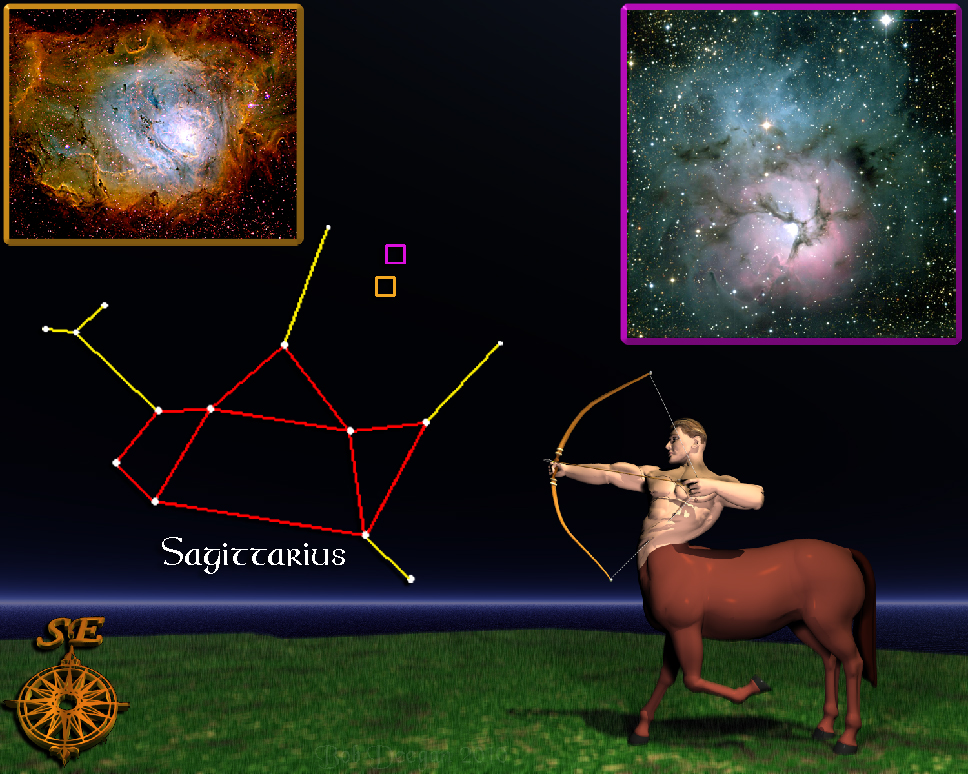
For the week including July 23, 2010

THE ARCHER
If you look overhead on summer nights, you can trace the stars of the Milky Way as a broad band of haze that looks like a long streak of high clouds. Follow it toward the southeastern horizon and you will come to the constellation of Sagittarius, the Archer. These stars represent Chiron, the greatest of the centaurs from Greek mythology. As a whole, centaurs had a pretty bad reputation among ancient Olympians. Their fondness for wine attracted them to parties and festivals, but their ensuing drunken behavior caused them to be dropped from many a guest list. Chiron, though, stood quite apart from the other centaurs. His wisdom and sage advice were much sought after. It was because of these attributes that he was asked to be the tutor of a young and unruly strongman named Hercules. Chiron taught Hercules music and poetry, literature and art. Unfortunately, he also decided to pass along his specialty – archery. After Hercules accidentally shot him, the gods placed Chiron and his bow among the stars. While this constellation supposedly depicts a mythical centaur, its brighter central stars (highlighted in red) remind many people of a child’s drawing of a teapot. Sagittarius is home to two of the most beautiful deep-space spectacles, the Lagoon and Trifid Nebulae.
On a dark, clear night, look at the spout of the Teapot and you will see two faintly luminous clouds floating above it like puffs of steam. The nebulae are actually stellar nurseries, huge clouds of gases and dust that are glowing with the ultraviolet radiation emitted from newborn stars. With the aid of binoculars you can see dozens of the young stars glittering like diamonds inside glowing clouds.
The Lagoon Nebula, shown in the photograph at upper left, is over one hundred light years across. Estimates of its distance vary, but recent measurements put it at about 5,200 light years away. Because of its naked-eye visibility, it was never actually discovered, but the bright cluster of stars inside the Lagoon Nebula appeared first in John Flamsteed’s compilation of astronomical phenomena in 1680. As telescope design improved, the Lagoon’s glowing clouds of gases were discovered in the 1740s. Shown in the photograph at upper right, the Trifid Nebula got its name from the astronomer John Herschel who observed that the nebula was roughly divided into three sections by indistinct dark lanes. Unfortunately for Herschel, the telescopes of his day did not allow for the clarity of detail available to us. Now, even through backyard telescopes, we can see a tremendous depth of structure in the Trifid. A photograph taken through even a small telescope shows a range of red, blue, and green hues in both the Lagoon and Trifid nebulae and reveals a great deal about the kinds of activity taking place among the clouds and stars. The colors of the nebulae are created when ultraviolet radiation from the hot young stars causes gases like oxygen and hydrogen to fluoresce like a neon sign.
Whether you explore the clouds of the Lagoon and Trifid nebulae with binoculars, telescope, or even the naked eye, they are bound to be favorites for your summer stargazing.The photographs of the Lagoon and Trifid nebulae are from the National Optical Astronomy Observatory.
Unless otherwise indicated, all content of this web site is the copyright of Robert Deegan and all rights are reserved.
For more information, or to comment, please contact: Bob@NightSkies.org